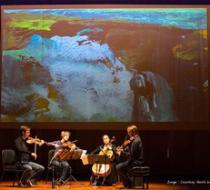The Crossroads Project 1 Favorite
This month’s blast of arctic air may have roused climate-change skeptics. But the composer Laura Kaminsky and the painter Rebecca Allan were unfazed. Holed up in their apartment in Riverdale in the Bronx on one of the coldest days in decades, these longtime artist-activists were doing what came naturally: fighting the planet’s warming.
The vehicle for their fight was a gathering, in person and by Skype, of principals in “The Crossroads Project,” a performance piece that draws on music, painting, photography and scientific research in an attempt to entertain, enlighten and, ultimately, encourage people to live sustainably.
The piece, which will have its New York-area premiere on Feb. 9 at Purchase College — where Ms. Kaminsky is a professor of music composition — is distinctive in a number of ways, not least its layered approach to mixing art and environmental activism. By operating on multiple levels, Ms. Kaminsky said, it “can potentially energize and activate the audience member in a way that just going to a lecture might not.”
“The big challenge,” she added, “was to create a narrative that ebbed and flowed.”
As the meeting moved forward, the complexity of the challenge became clear. Joining the proceedings by video link from the Performance Hall at Utah State University in Logan was the Fry Street Quartet, the university’s resident string ensemble. Also on the call from Utah was the physicist Robert Davies, who conceived the project and contributes scientific soliloquies that anchor the piece.
At Ms. Kaminsky’s side was Ms. Allan, whose abstract renderings of the natural world, strategically placed throughout the performance, both ease the transitions out of Mr. Davies’s soliloquies and provide commentary on them. Projected behind Mr. Davies and the quartet in Utah was Ms. Allan’s “Bronx River Reverie, 2014,” a multihued meditation that complements Ms. Kaminsky’s coloristic string quartet “Rising Tide,” her contribution to the project and its central performance feature.
The score for “Rising Tide” follows the conceptual framework Mr. Davies has laid out, with three movements evoking natural systems (“The Source of Life (H2O),” “Bios” and “Forage”) and a fourth representing human systems (“Societas”). In performance, each movement follows a Davies soliloquy as images are projected on one or more screens.
In Ms. Kaminsky’s writing — as in Mr. Davies’s disquisition — the fourth movement diverges sharply from the first three, adding qualitative instructions in English to the standard Italian-language dynamic markings and offering a window into the composer’s thinking. From the opening instruction (to play “serenely, with reverence; still, yet wandering”) to the closer (“again with reverence, and a bit of resignation”), a cautionary tale unfolds — without a note being played.
In choosing a selection to play for the gathering, the quartet steered clear of the legato-heavy “Societas,” opting instead for its lead-in, “Forage,” a vivid exercise in sustained, neatly articulated 16th notes. Looking past the shaky sound quality of her studio laptop, Ms. Kaminsky offered praise for the performance, tempered only by doubts about the balance between the second violin and the rest of the ensemble in a single passage.
Maintaining balance, it turns out, is an issue that extends beyond the aesthetics of any given performance. In making a string quartet central to the undertaking, the project’s leaders say they are positing that musical format as an ecosystem, a kind of metaphor for the interconnectivity of the natural world. Any loss of equilibrium in the musicians’ interplay thus becomes a commentary on the fragility of that world.
Just as the balance between the musical parts has been an issue, so too has the balance between the project’s artistic and scientific priorities. The issue has occasionally caused “creative tension,” Mr. Davies said, noting that, over some objections and at the expense of the piece’s pacing, he had added graphic material that helped drive home his points about sustainability.
“I think it’s a little bit longer than what we might ask for artistically,” he said.
Meanwhile, Mr. Davies acknowledged not having offered enough commentary on big money’s influence in shaping environmental policy, even as he expressed confidence in his decision to eliminate photographic references to specific corporations. The references, he said, often came across as heavy-handed and, with Garth Lenz’s photos of degraded landscapes and other scenes of devastation left in place, the piece has emerged stronger without them.
Not that this measure of restraint has mollified all skeptics. Mr. Davies said a performance in Libby Gardner Concert Hall at the University of Utah in Salt Lake City last April — one of eight performances since the work in its current form had its premiere in September 2012 — prompted critical letters and a handful of walkouts. Mostly, however, audiences have been sympathetic to the project’s message and, in some cases, motivated to take action.
Ms. Kaminsky said exposing her students to “The Crossroads Project” and requiring them to respond artistically to climate change has yielded “Freeze, Melt, Flood,” a multimedia piece that will be performed in the upper lobby of the Recital Hall before “Crossroads.” The piece will feature students’ original music and artwork, including an hourglass-shaped plexiglass sculpture through which melting ice will drip, symbolizing global warming and the passage of time. Microphones will capture the sound of water dripping as an actor reads deconstructed texts by the author Naomi Klein.
“The students started out sort of cynical and apathetic,” Ms. Kaminsky said. “By the middle of the semester, after having read a lot of articles and engaging with the content, they embraced it.”







